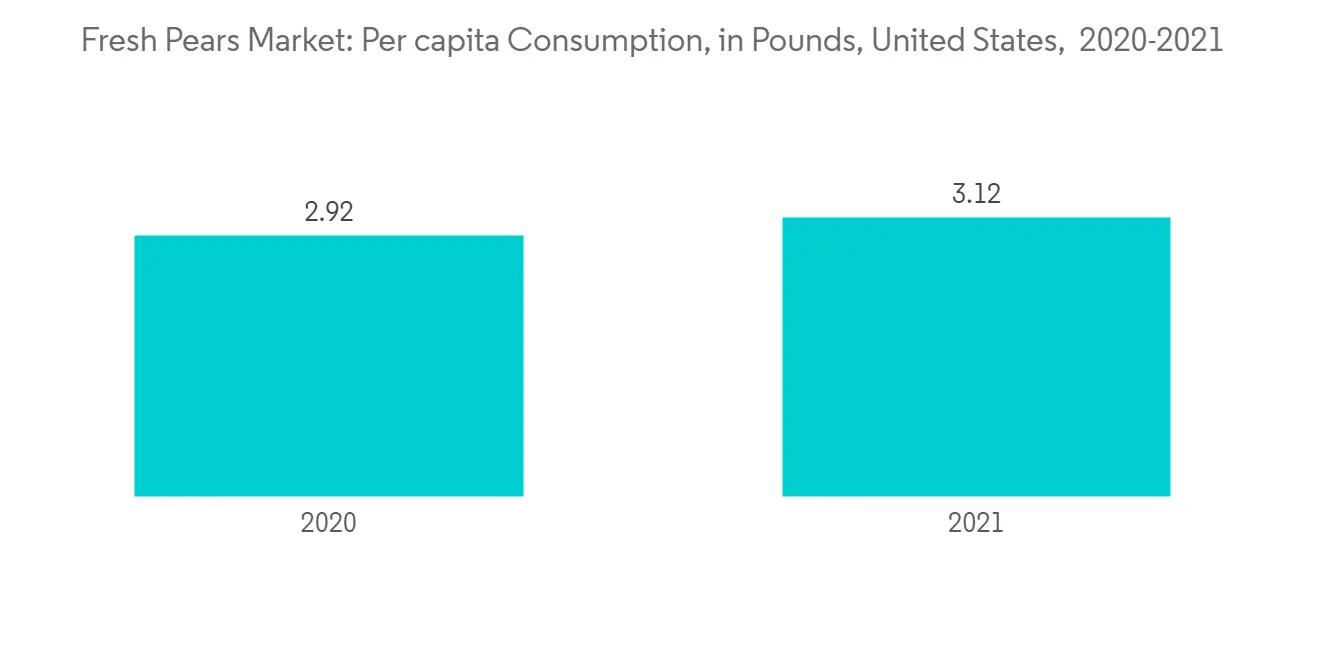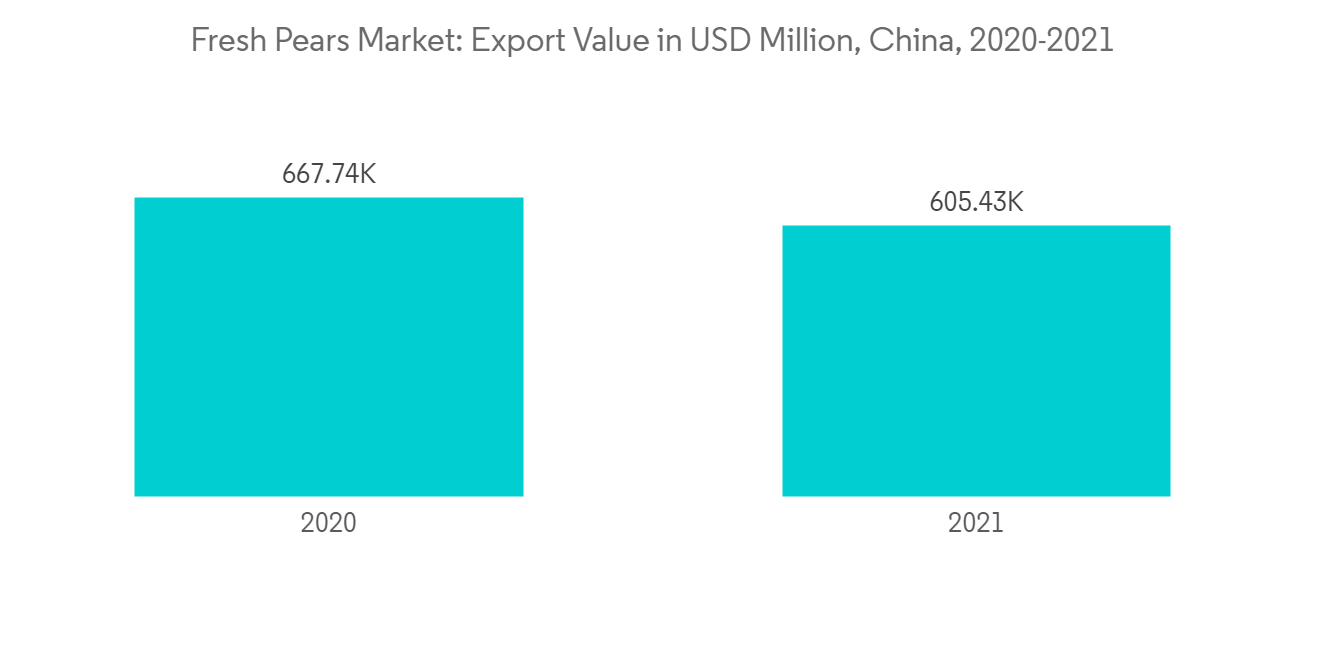 |
市場調查報告書
商品編碼
1273338
鮮梨市場 - COVID-19 的增長、趨勢、影響和預測 (2023-2028)Fresh Pears Market - Growth, Trends, and Forecasts (2023 - 2028) |
||||||
※ 本網頁內容可能與最新版本有所差異。詳細情況請與我們聯繫。
在預測期內,鮮梨市場的複合年增長率預計為 4.7%。
主要亮點
- 梨含有特殊的植物營養素,例如抗炎類黃酮、抗癌多酚和抗衰老類黃酮。 梨是維生素 C、維生素 K 和硼的最佳來源之一。 它可以減少炎症,這是大多數疾病的根本原因。 因此,這種水果的好處導致其主要在美國消費。 健康意識的增強和對有機水果的需求不斷增長是新鮮梨市場增長的主要推動力。
- 日本政府的目標是到 2030 年擴大年度農產品出口,因為國內消費會隨著人口減少而減少,特別是梨產業會考慮增加對各個市場的出口。
- 針對注重飲食習慣的高端消費者,在超市和保健食品店暢銷。 根據糧農組織統計數據庫,去年全球梨產量為 2560 萬噸,收穫面積為 130 萬公頃。 亞洲是最大的梨產區,去年產量為 2080 萬噸。
新鮮梨市場趨勢
美國鮮梨產量和人均消費量增加
梨是纖維和維生素 C 的重要來源,每個梨的熱量僅為 100 卡路裡。 它還不含鈉、膽固醇和脂肪,並含有 190 毫克的鉀。 根據美國農業部飲食指南,美國梨降低了幾種慢性病的風險,對國內梨生產和消費產生了很高的需求,這將在未來幾年加強市場。
根據糧農組織統計數據,2021年美國梨總產量為6.3639億噸,收穫面積為16876公頃。 從 2020 年到 2021 年,美國人均鮮梨消費量從 2.92 磅增加到 3.12 磅。
梨主要產於美國的華盛頓州和俄勒岡州。 華盛頓州是美國最大的鮮梨產地,佔全國梨產量的一半。 俄勒岡州和華盛頓州占美國梨產量的 25%。 西北梨主要產於華盛頓州的亞基馬和韋納奇地區以及俄勒岡州的羅格河和胡德河地區。
然而,獲得足夠的勞動力是一個大問題,與勞動力相關的成本也很高。 因此,預計在預測期內,利用 GPS 和可變速率技術等現代農業技術施用肥料和水來維持生產的經濟將提振市場。

中國是主要出口國和生產國
中國是世界上最大的梨生產國和出口國。 隨著氣溫逐漸回升,中國梨的銷售達到頂峰,清明節期間的國內採購和伊斯蘭世界開齋節期間的海外採購,兩個市場的需求增加,價格小幅上漲約 10%。 尤其是隨著生鮮電商的快速發展,消費者現在只需在平台上點擊一下,就可以購買到各種中國鮮梨。
根據 FAOSTAT 的數據,2021 年中國將生產 1890 萬噸鮮梨,出口 510138 噸,價值 605400 美元。 在中國,受全球大流行的影響,2021年的出口與上年相比略有下降。 據美國農業部對外農業服務局(FAS)稱,預計中國產量同比增長近2%。 儘管乾旱降低了中國東部省份的梨產量,但隨著其他地區的豐收,預計總產量將增加。
2020年人均梨消費量最高的國家是阿根廷、意大利、美國和中國。 這樣一來,世界範圍內對梨的需求量不斷增加,未來消費量有望增加,市場有望擴大。

鮮梨行業概況
其他福利:
- Excel 格式的市場預測 (ME) 表
- 3 個月的分析師支持
內容
第一章介紹
- 研究假設和市場定義
- 本次調查的範圍
第二章研究方法論
第 3 章執行摘要
第四章市場動態
- 市場概覽
- 市場驅動力
- 市場製約因素
- 供應鏈/價值鏈分析
第 5 章市場細分
- 地區
- 北美
- 美國
- 生產分析
- 消費市場分析(數量和價值)
- 進口市場分析(數量和價值)
- 出口市場分析(數量和價值)
- 價格趨勢分析
- 加拿大
- 生產分析
- 消費分析(數量和價值)
- 進口市場分析(數量和價值)
- 出口市場分析(數量和價值)
- 價格趨勢分析
- 墨西哥
- 生產分析
- 消費分析(數量和價值)
- 進口市場分析(數量和價值)
- 出口市場分析(數量和價值)
- 價格趨勢分析
- 歐洲
- 德國
- 生產分析
- 消費市場分析(數量和價值)
- 進口市場分析(數量和價值)
- 出口市場分析(數量和價值)
- 價格趨勢分析
- 波蘭
- 生產分析
- 消費分析(數量和價值)
- 進口市場分析(數量和價值)
- 出口市場分析(數量和價值)
- 價格趨勢分析
- 意大利
- 生產分析
- 消費分析(數量和價值)
- 進口市場分析(數量和價值)
- 出口市場分析(數量和價值)
- 價格趨勢分析
- 法國
- 生產分析
- 消費分析(數量和價值)
- 進口市場分析(數量和價值)
- 出口市場分析(數量和價值)
- 價格趨勢分析
- 土耳其人
- 生產分析
- 消費市場分析(數量和價值)
- 進口市場分析(數量和價值)
- 出口市場分析(數量和價值)
- 價格趨勢分析
- 亞太地區
- 中國
- 生產分析
- 消費市場分析(數量和價值)
- 進口市場分析(數量和價值)
- 出口市場分析(數量和價值)
- 價格趨勢分析
- 韓國
- 生產分析
- 消費市場分析(數量和價值)
- 進口市場分析(數量和價值)
- 出口市場分析(數量和價值)
- 價格趨勢分析
- 日本
- 生產分析
- 消費分析(數量和價值)
- 進口市場分析(數量和價值)
- 出口市場分析(數量和價值)
- 價格趨勢分析
- 印度
- 生產分析
- 消費市場分析(數量和價值)
- 進口市場分析(數量和價值)
- 出口市場分析(數量和價值)
- 價格趨勢分析
- 南美洲
- 巴西
- 生產分析
- 消費市場分析(數量和價值)
- 進口市場分析(數量和價值)
- 出口市場分析(數量和價值)
- 價格趨勢分析
- 阿根廷
- 生產分析
- 消費分析(數量和價值)
- 進口市場分析(數量和價值)
- 出口市場分析(數量和價值)
- 價格趨勢分析
- 智利
- 生產分析
- 消費分析(數量和價值)
- 進口市場分析(數量和價值)
- 出口市場分析(數量和價值)
- 價格趨勢分析
- 非洲
- 南非
- 生產分析
- 消費市場分析(數量和價值)
- 進口市場分析(數量和價值)
- 出口市場分析(數量和價值)
- 價格趨勢分析
- 埃及
- 生產分析
- 消費分析(數量和價值)
- 進口市場分析(數量和價值)
- 出口市場分析(數量和價值)
- 價格趨勢分析
- 北美
第六章市場機會與未來趨勢
The fresh pears market was projected to register a CAGR of 4.7% during the forecast period.
Key Highlights
- Pears contain special phytonutrients, including anti-inflammatory flavonoids, anticancer polyphenols, and anti-aging flavonoids. Pear is one of the best sources of vitamin C, vitamin K, and boron. It can help lower inflammation, which is the root cause of most diseases. Thus, the benefits of this fruit have, in turn, driven its consumption, majorly across the United States. The increasing health consciousness and the increasing demand for organic fruits act as the major driving forces behind the growth of the fresh pears market.
- The Japanese government is looking to export to various markets, the pear industry in particular, as domestic consumption is set to decrease with a declining population, so the country is aiming to expand its annual agriculture exports by 2030.
- The sales have been high in supermarkets and health food stores, targeting upscale consumers with specialized eating habits. According to FAOSTAT, global pear production accounted for 25.6 million metric tons last year, with a harvested area of 1.3 million hectares. Asia was the largest pear-producing region, with a production of 20.8 million metric tons last year.
Fresh Pears Market Trends
Increasing Production and Per capita consumption of Fresh Pears in United States
Pears are an excellent source of fiber and a good source of vitamin C for only 100 calories per serving. They are sodium-free, cholesterol-free, and fat-free and contain 190 mg of potassium. The USDA Dietary Guidelines for American pears will reduce their risk of some chronic diseases and this makes the high demand for domestic production and consumption of pears in the country and this will strengthen the market in coming years.
According to FAOSTAT, 2021, the total pear production in the United States was 636,390 thousand metric tons with a harvested area of 16,876 hectares. The United States per capita consumption of fresh pears increased from 2.92 pounds to 3.12 pounds from 2020 to 2021.
Pear is mainly produced in Washington and Oregon in the United States. Washington's fresh pear production is the largest in the United States, accounting for half of the pear production in the country. Oregon and Washington account for 25% of pear production in the United States. Northwest pears are majorly produced in the Yakima and Wenatchee areas of Washington and the Rogue River Valley and Hood river areas of Oregon.
Although finding adequate labor is a major concern and the cost associated with the labor is also high. As a result, modern techniques of farming are utilized, including GPS and variable rate technologies, for fertilizer and water applications to maintain production in the economy which will boost the market during the forecasting period.

China is the Major Exporter and Producer
China is the largest producer and exporter of pears in the world. With the gradual rise in temperatures, China's pears entered their period of peak sales and were affected by the domestic stocking for the Qingming Festival and overseas stocking for Muslim countries' Eid al-Fitr, the demand in both markets increased, leading to a slight rise in the price of fresh pears by about 10%. Merchants managed to increase sales through online and offline channels, especially with the rapid development of fresh food e-commerce, consumers can buy a variety of China's fresh pears through an easy click on the platforms.
According to FAOSTAT, 2021, China's fresh pear production was 18.9 million ton, and exported 510,138 ton of pears worth USD 605.4 thousand. In China, the export value has slightly declined in 2021, compared to the previous year due to the impact of the pandemic all over the world. According to the Foreign Agricultural Service (FAS) of the United States Department of Agriculture, China is anticipated to produce almost 2% higher than in the previous year. Though the drought has reduced the pear harvest in China's eastern provinces, the total production is expected to increase because of abundant harvests in other regions.
The countries with the highest levels of pear per capita consumption in 2020 were Argentina, Italy, the United States, and China. Thus, the increasing demand for pear worldwide, the market is expected to continue an upward consumption and tends to grow the market in the coming years.

Fresh Pears Industry Overview
Additional Benefits:
- The market estimate (ME) sheet in Excel format
- 3 months of analyst support
TABLE OF CONTENTS
1 INTRODUCTION
- 1.1 Study Assumptions & Market Definitions
- 1.2 Scope of the Study
2 RESEARCH METHODOLOGY
3 EXECUTIVE SUMMARY
4 MARKET DYNAMICS
- 4.1 Market Overview
- 4.2 Market Drivers
- 4.3 Market Restraints
- 4.4 Supply Chain/Value Chain Analysis
5 MARKET SEGMENTATION
- 5.1 Geography
- 5.1.1 North America
- 5.1.1.1 United States
- 5.1.1.1.1 Production Analysis
- 5.1.1.1.2 Consumption Analysis (Volume and Value)
- 5.1.1.1.3 Import Market Analysis (Volume and Value)
- 5.1.1.1.4 Export Market Analysis (Volume and Value)
- 5.1.1.1.5 Price Trend Analysis
- 5.1.1.2 Canada
- 5.1.1.2.1 Production Analysis
- 5.1.1.2.2 Consumption Analysis (Volume and Value)
- 5.1.1.2.3 Import Market Analysis (Volume and Value)
- 5.1.1.2.4 Export Market Analysis (Volume and Value)
- 5.1.1.2.5 Price Trend Analysis
- 5.1.1.3 Mexico
- 5.1.1.3.1 Production Analysis
- 5.1.1.3.2 Consumption Analysis(Volume and Value)
- 5.1.1.3.3 Import Market Analysis (Volume and Value)
- 5.1.1.3.4 Export Market Analysis (Volume and Value)
- 5.1.1.3.5 Price Trend Analysis
- 5.1.2 Europe
- 5.1.2.1 Germany
- 5.1.2.1.1 Production Analysis
- 5.1.2.1.2 Consumption Analysis(Volume and Value)
- 5.1.2.1.3 Import Market Analysis (Volume and Value)
- 5.1.2.1.4 Export Market Analysis (Volume and Value)
- 5.1.2.1.5 Price Trend Analysis
- 5.1.2.2 Poland
- 5.1.2.2.1 Production Analysis
- 5.1.2.2.2 Consumption Analysis (Volume and Value)
- 5.1.2.2.3 Import Market Analysis (Volume and Value)
- 5.1.2.2.4 Export Market Analysis (Volume and Value)
- 5.1.2.2.5 Price Trend Analysis
- 5.1.2.3 Italy
- 5.1.2.3.1 Production Analysis
- 5.1.2.3.2 Consumption Analysis (Volume and Value)
- 5.1.2.3.3 Import Market Analysis (Volume and Value)
- 5.1.2.3.4 Export Market Analysis (Volume and Value)
- 5.1.2.3.5 Price Trend Analysis
- 5.1.2.4 France
- 5.1.2.4.1 Production Analysis
- 5.1.2.4.2 Consumption Analysis (Volume and Value)
- 5.1.2.4.3 Import Market Analysis (Volume and Value)
- 5.1.2.4.4 Export Market Analysis (Volume and Value)
- 5.1.2.4.5 Price Trend Analysis
- 5.1.2.5 Turkey
- 5.1.2.5.1 Production Analysis
- 5.1.2.5.2 Consumption Analysis (Volume and Value)
- 5.1.2.5.3 Import Market Analysis (Volume and Value)
- 5.1.2.5.4 Export Market Analysis (Volume and Value)
- 5.1.2.5.5 Price Trend Analysis
- 5.1.3 Asia Pacific
- 5.1.3.1 China
- 5.1.3.1.1 Production Analysis
- 5.1.3.1.2 Consumption Analysis (Volume and Value)
- 5.1.3.1.3 Import Market Analysis (Volume and Value)
- 5.1.3.1.4 Export Market Analysis (Volume and Value)
- 5.1.3.1.5 Price Trend Analysis
- 5.1.3.2 South Korea
- 5.1.3.2.1 Production Analysis
- 5.1.3.2.2 Consumption Analysis (Volume and Value)
- 5.1.3.2.3 Import Market Analysis (Volume and Value)
- 5.1.3.2.4 Export Market Analysis (Volume and Value)
- 5.1.3.2.5 Price Trend Analysis
- 5.1.3.3 Japan
- 5.1.3.3.1 Production Analysis
- 5.1.3.3.2 Consumption Analysis (Volume and Value)
- 5.1.3.3.3 Import Market Analysis (Volume and Value)
- 5.1.3.3.4 Export Market Analysis (Volume and Value)
- 5.1.3.3.5 Price Trend Analysis
- 5.1.3.4 India
- 5.1.3.4.1 Production Analysis
- 5.1.3.4.2 Consumption Analysis (Volume and Value)
- 5.1.3.4.3 Import Market Analysis (Volume and Value)
- 5.1.3.4.4 Export Market Analysis (Volume and Value)
- 5.1.3.4.5 Price Trend Analysis
- 5.1.4 South America
- 5.1.4.1 Brazil
- 5.1.4.1.1 Production Analysis
- 5.1.4.1.2 Consumption Analysis (Volume and Value)
- 5.1.4.1.3 Import Market Analysis (Volume and Value)
- 5.1.4.1.4 Export Market Analysis (Volume and Value)
- 5.1.4.1.5 Price Trend Analysis
- 5.1.4.2 Argentina
- 5.1.4.2.1 Production Analysis
- 5.1.4.2.2 Consumption Analysis (Volume and Value)
- 5.1.4.2.3 Import Market Analysis (Volume and Value)
- 5.1.4.2.4 Export Market Analysis (Volume and Value)
- 5.1.4.2.5 Price Trend Analysis
- 5.1.4.3 Chile
- 5.1.4.3.1 Production Analysis
- 5.1.4.3.2 Consumption Analysis (Volume and Value)
- 5.1.4.3.3 Import Market Analysis (Volume and Value)
- 5.1.4.3.4 Export Market Analysis (Volume and Value)
- 5.1.4.3.5 Price Trend Analysis
- 5.1.5 Africa
- 5.1.5.1 South Africa
- 5.1.5.1.1 Production Analysis
- 5.1.5.1.2 Consumption Analysis (Volume and Value)
- 5.1.5.1.3 Import Market Analysis (Volume and Value)
- 5.1.5.1.4 Export Market Analysis (Volume and Value)
- 5.1.5.1.5 Price Trend Analysis
- 5.1.5.2 Egypt
- 5.1.5.2.1 Production Analysis
- 5.1.5.2.2 Consumption Analysis (Volume and Value)
- 5.1.5.2.3 Import Market Analysis (Volume and Value)
- 5.1.5.2.4 Export Market Analysis (Volume and Value)
- 5.1.5.2.5 Price Trend Analysis
- 5.1.1 North America





